Dig in to the fresh, aromatic and umami-rich flavors for Laotian cuisine with this Laos Meat Salad. Made with diced cooked beef, lemongrass, ginger and lots of fresh herbs, this Laotian meat salad is an easy to make meal with complex flavors. Serve it with rice and fresh crunchy lettuce leaves for a quick and healthy dinner.
Why You’ll Love This Laos Meat Salad
- Full of Umami Flavor: Each bite of this laos meat salad is full of savory, salty umami flavor. All of that is balanced out with aromatics and fresh herbs. It’s truly a trip for the tastebuds.
- Approachable and Convenient: I’ve taken the liberty of swapping some traditional ingredients for easier-to-find ingredients for the average American consumer. Because of that, this is not an uber traditional recipe for Laos Meat Salad. Check out the substitutions I have made in the Expert Tips section below.
- Quick to Make: start to finish, this salad comes together in about 30 minutes. Not bad for a delicious dinner!
What is Laotian Meat Salad?
Laotian meat salad, more commonly known as “Nam Tok” is a simple yet complex-flavored meat salad. It’s generally made with sliced or diced grilled beef and tossed with its juices, lime juice, fish sauce, aromatics, herbs and toasted rice powder.
Larb, on the other hand, is made with minced and cooked meat such as chicken, pork or beef and is seasoned similarly. If you’re looking for a ground meat larb, try Beef Larb or Chicken Larb.
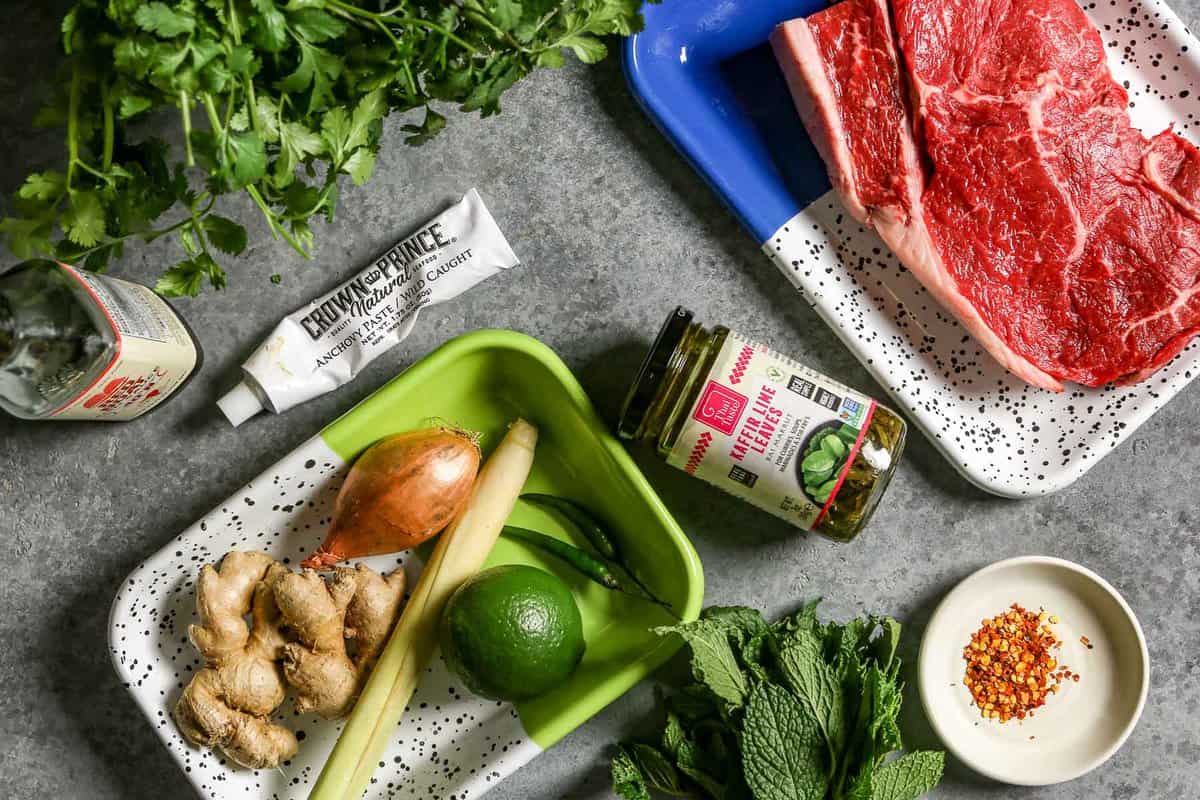
Ingredients Needed
- Steak: you’ll need one large steak that weighs 1 to 1 ½ pounds. My favorite cut of steak for this salad is a Top Sirloin but a New York Strip is also a great option.
- Shallot: grab 1 medium shallot for this recipe. I recommend slicing and soaking it in cold water while you prep the other ingredients. This washes away the harsh flavor of the shallot that tends to hang around as an after taste for hours.
- Herbs: cilantro and mint are the two herbs you’ll need for this recipe. You’ll need 1 bunch of each.
- Lemongrass: this is an important part of the salad. Lemongrass adds an aromatic citrusy flavor to the dish that really brightens everything up. (It also pairs well with kaffir lime leaves).
- Kaffir lime leaves: I like to use jarred sliced kaffir lime leaves. I find they’re more convenient than seeking out fresh or buying dried. I usually get mine at Whole Foods—they’re great in all kinds of Southeast Asian cooking like Coconut Curry Mussels. You can also use dried kaffir lime leaves instead, just be sure to hydrate them in hot water before using.
- Ginger: I opt to use fresh ginger (and lemongrass) instead of galangal. They’re easier to find and add a similar flavor.
- Red pepper flakes: measure this with your tastebuds. I recommend starting with ½ teaspoon and adjusting to your desired spice level.
- Fish Sauce: traditionally, Padaek is used in Laos Meat Salad. It’s a fermented fish sauce that has chunks of fish in it. I’ve opted to use fish sauce with a bit of anchovy paste for a more convenient option, thanks to the recommendation from Cooking with Lane.
- Anchovy paste: you’ll need just ½ a teaspoon, but it’s worth it here! Put the rest of the anchovy paste to work in a Beef and Cabbage Soup, Pasta e Ceci or Homemade Mayonnaise-Based Caesar Dressing.
- Lime: you’ll need the juice of 1 lime for this salad.
- Toasted rice powder: I list this as optional, but talk to any Laotian and they will tell you that toasted rice powder adds a signature flavor and thickens the sauces of the salad. You can make it at home (I’ve got a recipe for it in my Thai Steak Salad) or buy it online. This salad is also delicious if you opt to leave it out.
- Thai chiles: If you like a kick of heat, add thinly sliced thai chiles to the salad!
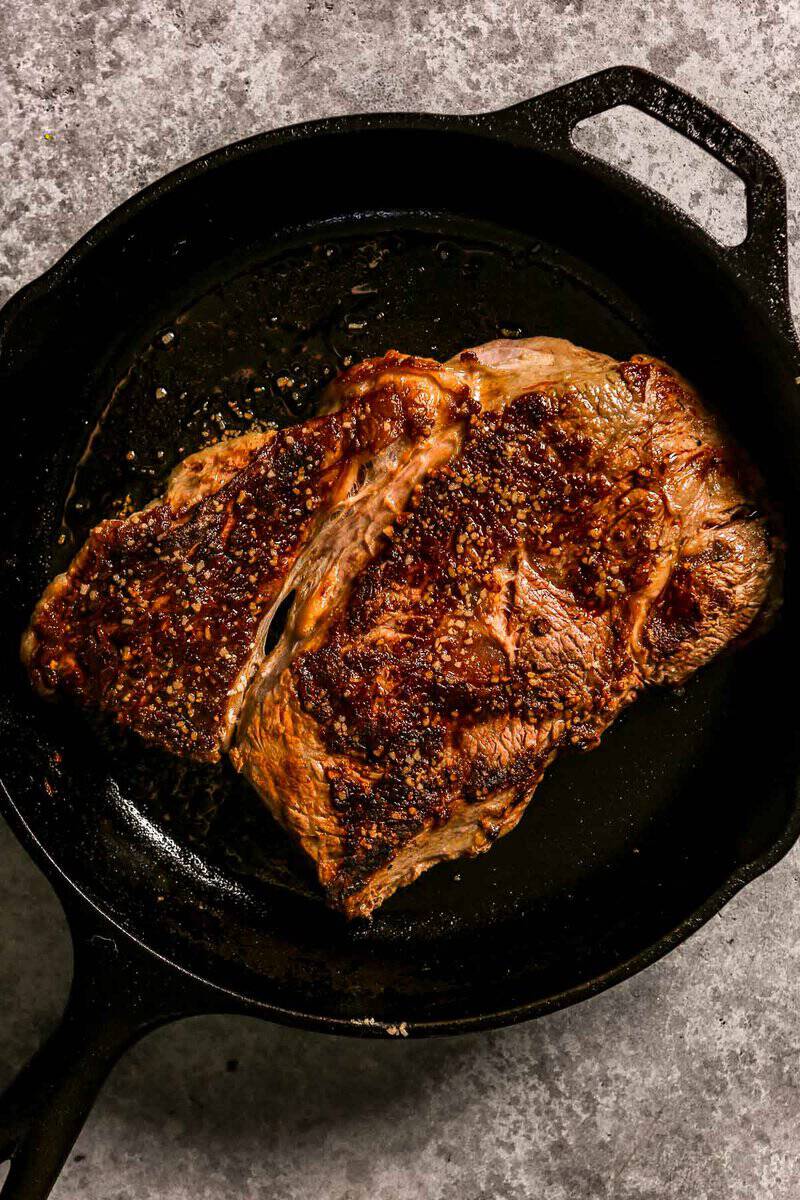
How to Make Laos Meat Salad
- Cook the steak in a cast-iron skillet until browned on both sides and cooked to your desired liking. I prefer the steak done to medium-rare, but you can cook it to whatever doneness you like.
- Prep the aromatics including the shallots, ginger, lemongrass, kaffir lime leaves, and herbs.
- Rest the steak. It’s important to let the steak rest for about 10 minutes before slicing and dicing it up. Tent it loosely with a piece of foil while it rests.
- Cut up the steak. Slice the steak against the grain into thin strips then cut the strips into a small dice. Add the steak to a large mixing bowl.
- Toss the salad together. Add the aromatics, herbs and drained shallots to the bowl with the steak. Add the fish sauce, anchovy paste, lime juice and toasted rice powder (if using) and toss everything together. Season to taste with additional salt and lime juice before serving.
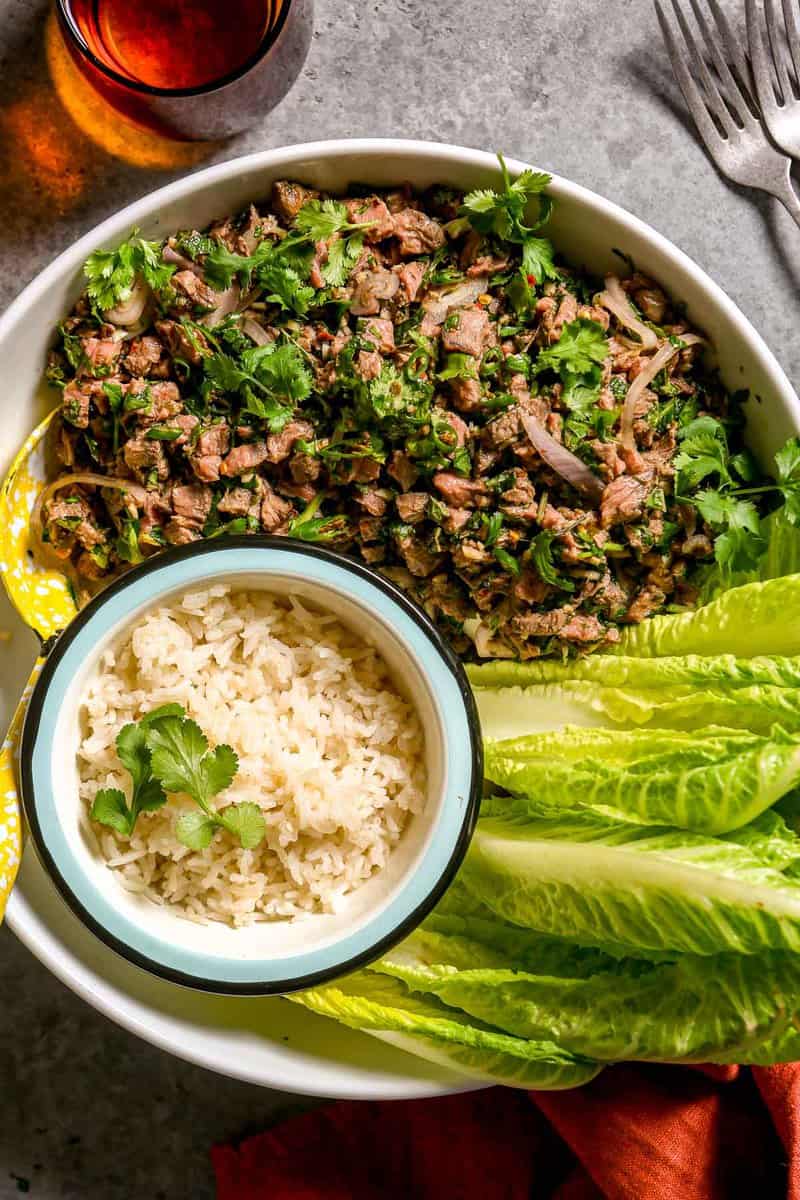
Serving Suggestions
I recommend serving this Laotian-inspired Meat Salad as lettuce cups with cooked jasmine rice that’s been seasoned with salt, toasted sesame oil and sesame seeds, alongside large leaves of romaine, iceberg or bibb lettuce.
You can also serve this simply over rice with some added veggies like sliced Persian cucumbers.
Expert Tips from the Test Kitchen
To make this recipe approachable and to encourage the exploration of new flavors, I’ve made a few ingredient substitutions.
- Instead of galangal, which I found to be hard to find, I’m using a combination of ginger and lemongrass. These two ingredients are a bit more aromatic but do a nice job of hitting the spicy and citrusy notes of galangal. The only flavors missing from these two ingredients that galagal would add is some earthiness and pepperiness. If you can find galangal, use that instead!
- Instead of fresh or dried kaffir lime leaves I like to use jarred kaffir lime leaves—this way they’re always recipe to use. You can use dried kaffir lime leaves, just be sure to hydrate them in hot water for a few minutes before using.
- Instead of padaek, which is a fermented fish sauce, I’m using a combination of fish sauce and anchovy paste. Together, this combination adds a similar flavor to the Laos meat salad and it’s fairly likely you already have one or the other on hand.
- Traditionally, Lao Meat Salad uses toasted rice powder which adds a nutty flavor and slightly creamy texture. You can certainly add it (start with a tablespoon) but I’ve chosen to leave it out of this recipe for ease.
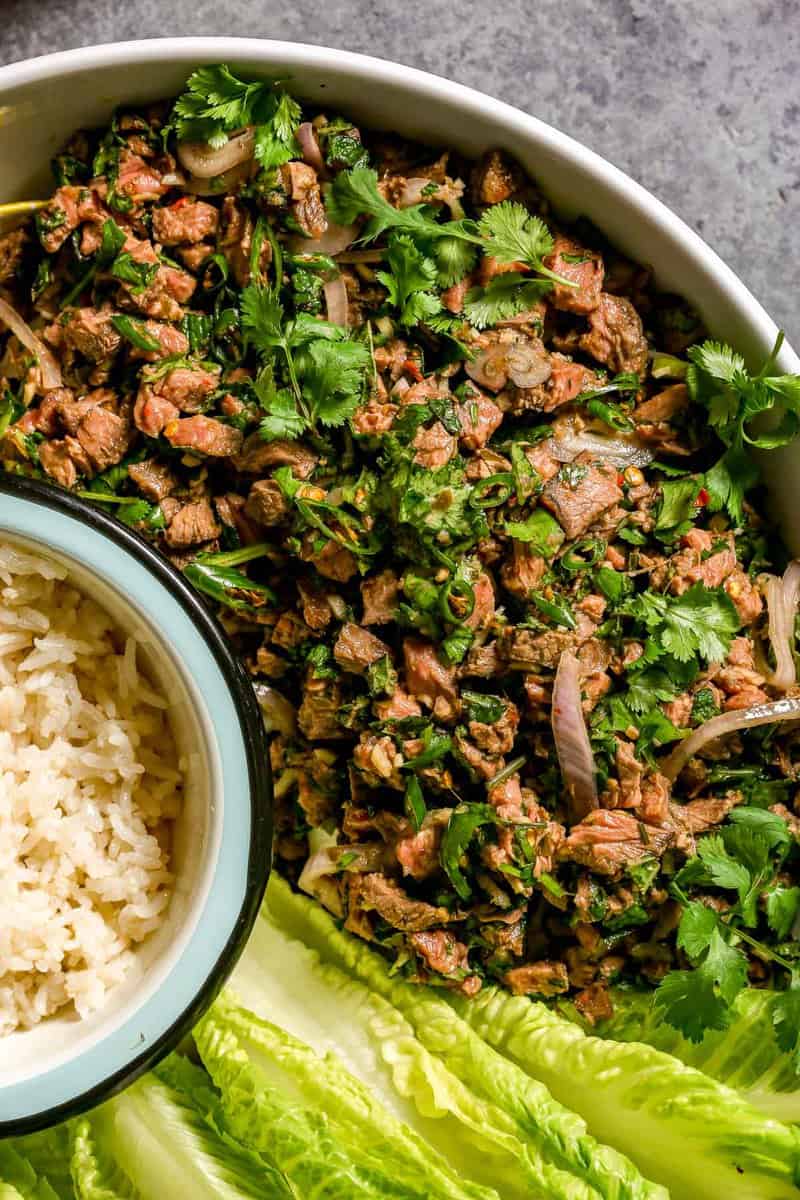
More Recipes You May Like
- Bun Cha Salad is a great weeknight meal or summer weekend lunch. It’s my (salad) version of the classic Vietnamese meatball and noodle dish.
- Give the classic cabbage slaw a flavor upgrade with this Miso Cabbage Salad.
- Thai Larb is an absolute must if you like this Laos salad. Try a Beef Larb or Chicken Larb.
Laos-Inspired Meat Salad
Description
Ingredients
- 1 medium shallot, thinly sliced
- 1 (1–1 ½ pound) top sirloin or NY Strip steak
- Kosher Salt
- ½ bunch cilantro, roughly chopped
- ⅓ cup loosely packed fresh mint leaves, roughly chopped
- 1 heaping tablespoon minced fresh lemongrass (from 1 lemongrass)
- 1 tablespoon minced jarred kaffir lime leaves
- 2 teaspoons grated ginger
- ½–1 teaspoon crushed red pepper flakes
- 2 teaspoons fish sauce (or Padaek)
- ½ teaspoon anchovy paste (or Padaek)
- 1 lime, juiced
- 2 tablespoons toasted rice powder, optional
- 1–2 thai chiles, sliced, optional
For Serving
- Romaine heart leaves, iceberg lettuce or bibb lettuce
- Cooked jasmine rice, seasoned with toasted sesame oil, sesame seeds and salt
Instructions
- Thinly slice 1 shallot then add to a bowl and cover with cold water; set aside.
- Heat a cast-iron skillet over medium heat for 5 minutes.
- Pat steak dry then season generously with salt (at least 1 teaspoon).
- Add steak to skillet and cook, without touching, until steak naturally releases from pan and is golden brown, about 4 minutes, flip and continue to cook until golden brown on second side and an instant-reader thermometer registers 125ºF for medium-rare, 135ºF for medium, or 145ºF for well done.
- Transfer steak to a plate, tent loosely with foil and let rest 10 minutes.
- Transfer steak to a cutting board and cut into thin strips, against the grain. Cut strips into a small dice; transfer diced steak to a large mixing bowl.
- Drain shallot and add to bowl with steak along with ½ bunch chopped cilantro, ⅓ cup chopped mint, 1 tablespoons minced lemongrass, 1 tablespoon minced kaffir leaves, 2 teaspoons grated ginger, and ½ teaspoon pepper flakes.
- Whisk together 2 teaspoon fish sauce and ½ teaspoon anchovy paste in a small bowl. Add fish sauce mixture and juice of 1 lime juice to salad; toss to combine. Stir in 1 tablespoon toasted rice powder, if using. Season to taste with additional salt, pepper flakes and lime juice.
- Transfer salad to a large serving bowl or platter and top with sliced chiles, if using. Serve with sesame rice and large lettuce leaves.
Equipment
Notes
Nutrition
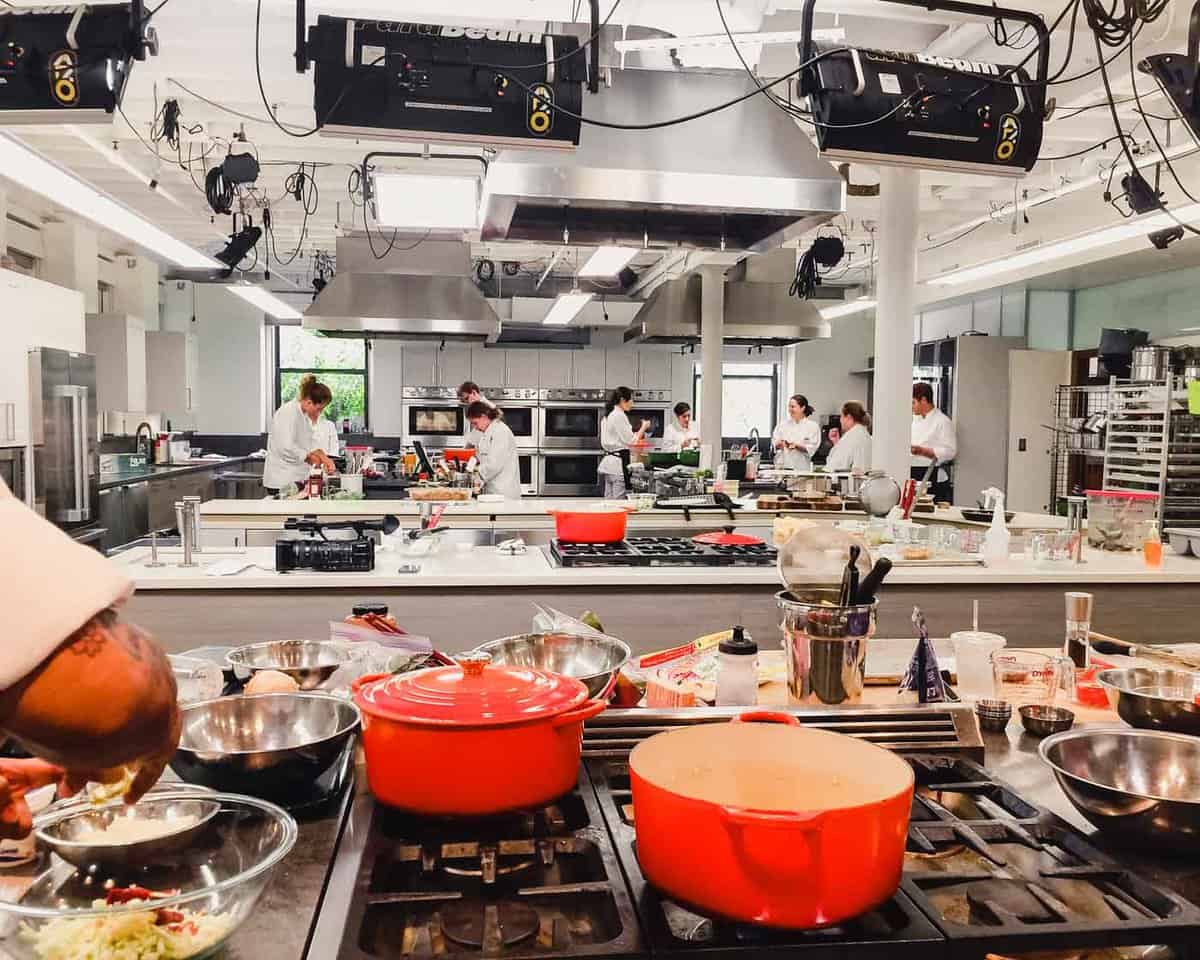
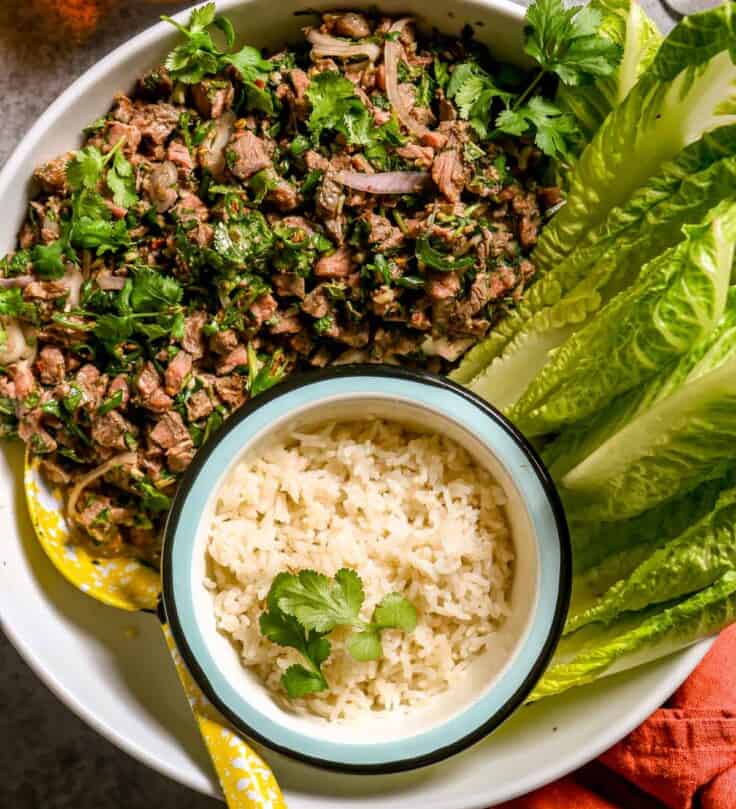
Came here via Tiktok. My cultural dishes are constantly diluted for American audiences, and it’s incredibly frustrating. I’d challenge you to rethink your approach to “global flavors” because it isn’t new and it harms perceptions of our food.
In the video, you said you wanted to introduce padaek to a broader audience but it’s not even in this recipe. I’m not Laotian, but in my experience substitutions can dramatically change flavors.
If you want to be an ambassador for our food, genuinely engage. Encourage your followers to seek out challenging ingredients and make the entire authentic recipe or use these ingredients in other American dishes. Elevate creators from these communities and credit your recipe development references. Cite specific cultures instead of “Asian” or “Middle Eastern” when naming recipes. Otherwise, let us represent our food ourselves.
Hi Em,
Thanks for your comment. I’ve added a link to a traditional recipe for Lao Nam Tok in the article. You’re right, I should have cited a traditional recipe (and if you take a look around the site, you will notice most of the recipes that are inspired by specific dishes do have links to information and traditional recipes).
I did not title the recipe by its traditional name because I wasn’t trying to present it as such. It’s a meat salad made with Laotion flavors and ideas.
The recipe has always been written with options to use Padaek. As a recipe developer and someone who researches—on foot—what types of products are available around the country (I have lived in 6 different cities of the US in the last 4 years) I know how important it is to offer substitutions.
That’s the reality of cooking.
And the reality is I am a recipe developer in the United States.
The substitution I made came after a lot of research and referencing Laotian and Thai recipes. This substitution was directly recommended from a Laotian creator, which I will be sure to link to (another great point you made). Assuming I do not preform due diligence when making substitutions is simply short sighted.
I understand the value of citing specific cultures, but it’s not the only way to talk about food and regions of the world. I do not believe food is binary and I certainly don’t think there should be a “right” way and a “wrong” way to talk about cuisines. If anything, that will ostracize people from even exploring or opening up their world view.
Asian, Middle Eastern, Central American, European—these are all valid ways to specify a region. And when talking about cuisine, you often have to start regional before you further define a more specific area. Does getting more granular give a recipe more context? Of course! But when offering a group of recipes the reader may like, I firmly believe it is acceptable to talk about them as a regional group of dishes. Because otherwise, where does it end? Would you find it unacceptable if I listed a set of recipes as Italian if some of them were from the Tuscan region while others were from Umbria, Sicily or Puglia?
I appreciate your comment—it has given me a lot to think about and I understand where you are coming from. I hope this gives you some insight into my point of view.
I appreciate you engaging with the criticism and updating the recipe to reflect some of my points.
Ultimately, if your goal is to “introduce global flavors,” authentic key ingredients and cultural context are needed. Otherwise, what and who exactly is being introduced? Do the people from that culture feel more understood, or less?
Using a dish’s key ingredients and specifying its national origins demonstrate respect. Requesting respect isn’t imposing a right vs. wrong approach to food.
If these cultures are so underrepresented they require an “introduction,” isn’t naming their dishes as Indian or Korean instead of Asian more effective? If no one says “European Salad” in lieu of Italian or Russian, it’s disingenuous to argue “Asian” is appropriate or accurately describes the culinary traditions of over two billion people.
Asian American cooks live all over the country, dealing with the same ingredient landscape. I grew up in the Midwest before Amazon Prime and we managed. A substitution-first approach often misses the spirit of the original but also doesn’t seem necessary as even once-obscure ingredients are now easily shipped.
You seem talented, with some really playful and fun recipes. With a little more workshopping, I think people could really appreciate your cross-cultural recipes as well.